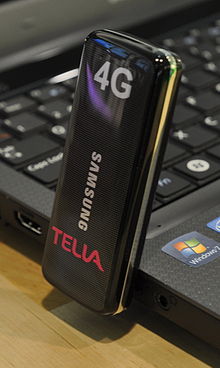
4G refers to the fourth generation of cellular wireless standards. It is a successor to 3G and 2G
families of standards. The nomenclature of the generations generally
refers to a change in the fundamental nature of the service,
non-backwards compatible transmission technology, and new frequency
bands. The first was the move from 1981 analog (1G) to digital (2G)
transmission in 1992. This was followed, in 2002, by 3G multi-media
support, spread spectrum transmission and at least 200 kbit/s, soon expected to be followed by 4G, which refers to all-IP packet-switched networks, mobile ultra-broadband (gigabit speed) access and multi-carrier transmission. Pre-4G technologies such as mobile WiMAX and first-release 3G Long term evolution (LTE) have been available on the market since 2006 and 2009 respectively.
Predecessors of 4G
LTE
Telia-branded Samsung LTE modem
The world's first publicly available LTE-service was opened in the two Scandinavian capitals Stockholm (Ericsson system) and Oslo (a Huawei system) on the 14 December 2009, and branded 4G. The user terminals were manufactured by Samsung The two largest major mobile carriers in the United States and several worldwide carriers have announced plans to convert their networks to LTE beginning in 2011.
The physical radio interface was at an early stage named High Speed OFDM Packet Access (HSOPA), now named Evolved UMTS Terrestrial Radio Access (E-UTRA).
LTE Advanced (Long-term-evolution Advanced) is a candidate for IMT-Advanced standard, formally submitted by the 3GPP organization to ITU-T in the fall 2009, and expected to be released in 2012. The target of 3GPP LTE Advanced is to reach and surpass the ITU requirements. LTE Advanced should be compatible with first release LTE equipment, and should share frequency bands with first release LTE.
WiMAX
The Mobile WiMAX (IEEE 802.16e-2005) mobile wireless broadband access (MWBA) standard is sometimes branded 4G, and offers peak data rates of 128 Mbit/s downlink and 56 Mbit/s uplink over 20 MHz wide channels. The IEEE 802.16m evolution of 802.16e is under development, with the objective to fulfill the IMT-Advanced criteria of 1 Gbit/s for stationary reception and 100 Mbit/s for mobile reception.The world's first commercial mobile WiMAX service was opened by KT in Seoul, South Korea on 30 June 2006.Sprint Nextel has begun using WiMAX, branded as a "4G" network.
UMB (formerly EV-DO Rev. C)
UMB (Ultra Mobile Broadband) was the brand name for a discontinued 4G project within the 3GPP2 standardization group to improve the CDMA2000 mobile phone standard for next generation applications and requirements. In November 2008, Qualcomm, UMB's lead sponsor, announced it was ending development of the technology, favouring LTE instead. The objective was to achieve data speeds over 275 Mbit/s downstream and over 75 Mbit/s upstream.Flash-OFDMAt an early stage the Flash-OFDM system was expected to be further developed into a 4G standard.
Objective and approach
Objectives
4G is being developed to accommodate the quality of service (QoS) and rate requirements set by further development of existing 3G applications like mobile broadband access, Multimedia Messaging Service (MMS), video chat, mobile TV, but also new services like HDTV. 4G may allow roaming with wireless local area networks, and may interact with digital video broadcasting systems.The 4G working group has defined the following as objectives of the 4G wireless communication standard:
- Flexible channel bandwidth, between 5 and 20 MHz, optionally up to 40 MHz.
- A nominal data rate of 100 Mbit/s while the client physically moves at high speeds relative to the station, and 1 Gbit/s while client and station are in relatively fixed positions as defined by the ITU-R,
- A data rate of at least 100 Mbit/s between any two points in the world,
- Peak link spectral efficiency of 15 bit/s/Hz in the downlink, and 6.75 bit/s/Hz in the uplink (meaning that 1 Gbit/s in the downlink should be possible over less than 67 MHz bandwidth)
- System spectral efficiency of up to 3 bit/s/Hz/cell in the downlink and 2.25 bit/s/Hz/cell for indoor usage.
- Smooth handoff across heterogeneous networks,
- Seamless connectivity and global roaming across multiple networks,
- High quality of service for next generation multimedia support (real time audio, high speed data, HDTV video content, mobile TV, etc.)
- Interoperability with existing wireless standards,and
- An all IP, packet switched network.
- Femtocells (home nodes connected to fixed Internet broadband infrastructure)
Approaches
Consideration points
- Coverage, radio environment, spectrum, services, business models and deployment types, users.
Principal technologies
- Physical layer transmission techniques
- MIMO: To attain ultra high spectral efficiency by means of spatial processing including multi-antenna and multi-user MIMO
- Frequency-domain-equalization, for example Multi-carrier modulation (OFDM) or single-carrier frequency-domain-equalization (SC-FDE) in the downlink: To exploit the frequency selective channel property without complex equalization.
- Frequency-domain statistical multiplexing, for example (OFDMA) or (Single-carrier FDMA) (SC-FDMA, a.k.a. Linearly precoded OFDMA, LP-OFDMA) in the uplink: Variable bit rate by assigning different sub-channels to different users based on the channel conditions
- Turbo principle error-correcting codes: To minimize the required SNR at the reception side
- Channel-dependent scheduling: To utilize the time-varying channel.
- Link adaptation: Adaptive modulation and error-correcting codes
- Relaying, including fixed relay networks (FRNs), and the cooperative relaying concept, known as multi-mode protocol



